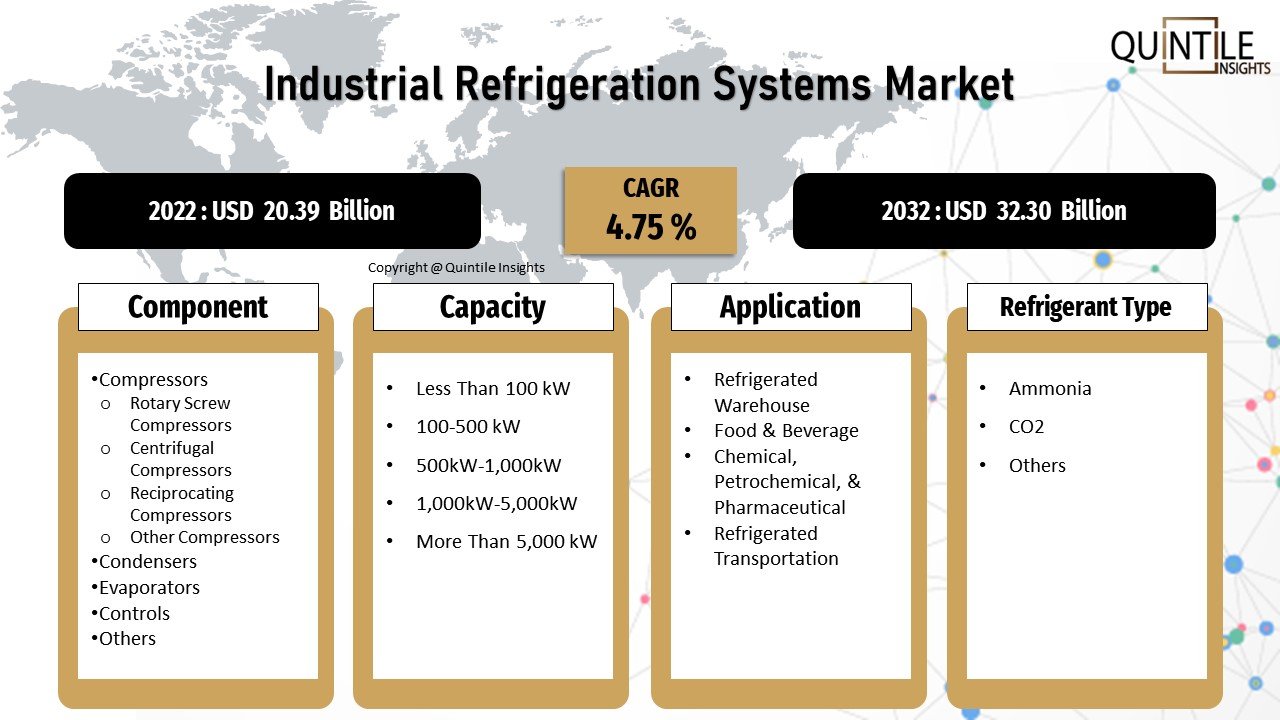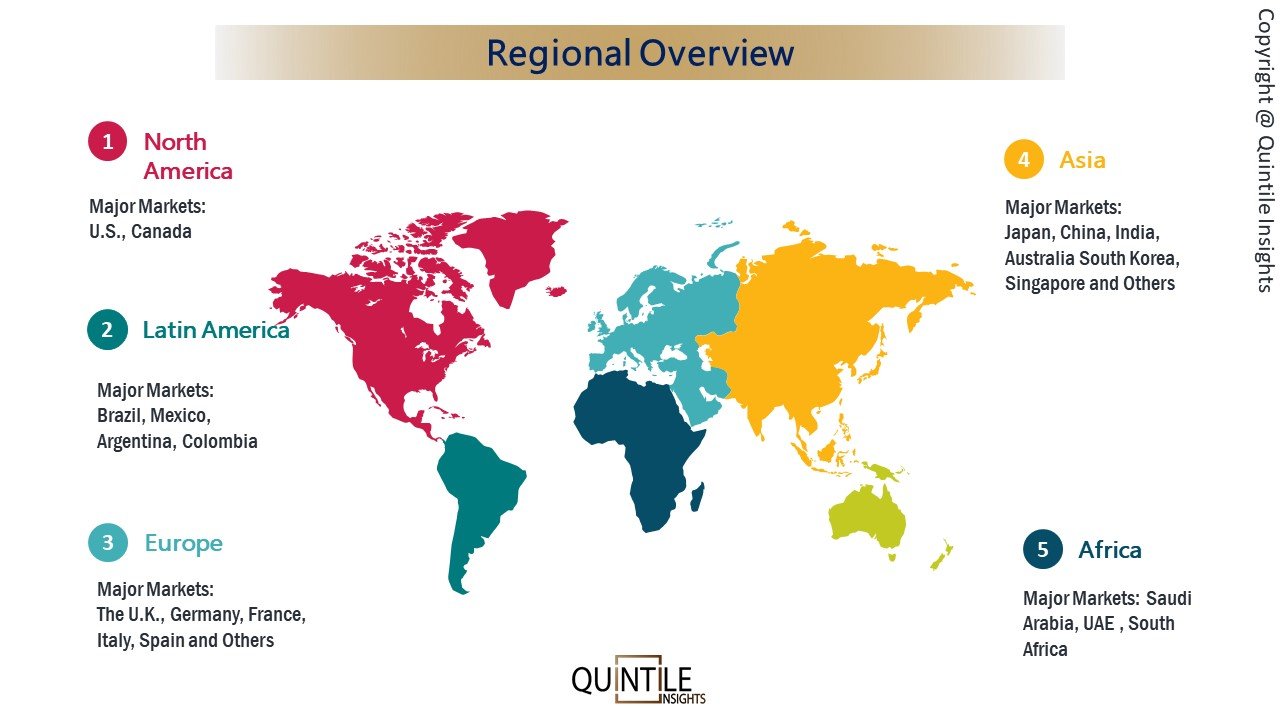MARKET SUMMARY
The global
industrial refrigeration systems market was valued at USD 20.39 Billion in 2022 and it is
predicted to rise at a compound annual growth rate (CAGR) of 4.75 % from 2023 to 2032. The use
of packaged, processed foods and beverages along with the requirement to stop
spoiling are driving up demand for industrial refrigeration systems on a global
scale. Global warming worries have compelled businesses to prioritize natural
refrigerants over hazardous coolants. Due to the low cost of production and
environmental neutrality of natural refrigerants, the market for real
refrigerant-based equipment has recently outgrown itself. The global adoption
of upgraded and improved cold chain systems is anticipated to have an impact on
the market during the projected period.
When temperature control of the
materials is necessary, industrial refrigeration systems is used in a variety
of end-use sectors, including the processing of food and beverages, chemical
processing, and cold storage applications. Such goods are in high demand for
HVAC, beverage production, process cooling, and food processing.
“Increasing Use of Packaged
Foods Globally Fuels the Market”
Industrial operations have been impacted by the pandemic's onset as manufacturing hubs have stopped due to lockdowns and quarantines enacted by governments around the world. However, because to the requirement for massive quantities of vaccinations to be preserved globally to combat the pandemic's scope, the market saw a demand for its products. The Centers for Disease Control and Prevention (CDC) in the United States advise using pharmaceutical or freezers or refrigerators that are especially made for storing vaccinations. The recommended storage temperatures for vaccinations were 2°C to 8°C for refrigerators and -50°C to -15°C for freezers. As a result, the market was kept alive by the necessity to store and distribute effective medicines and vaccines.

To learn
more about this report, request
a free sample copy
SEGMENT OUTLOOK:
The global industrial
refrigeration systems market is segmented based on Component, Capacity, Application,
and Refrigerant Type
Based on Components, the industrial
refrigeration systems market is segmented into compressors, condensers, evaporators, controls, and others. Due to
its major characteristics, including pressure building, use control, and
financial capability, the compressor industry is anticipated to see the
quickest CAGR between 2023 and 2032. Compressors offer a reliable and effective
driving power for more streamlined manufacturing operations. Centrifugal,
reciprocating, rotatory screws, and other types of compressors can be used to
identify them from one another. Reciprocal compressors had a significant impact
on the market in terms of revenue share in 2022. Its advantages, including high-pressure ranges of up to 30000 PSI, energy efficiency, and the availability of
oil-free and oil-flooded variations, are the key drivers of its expansion.
According
to projections, the compressor category will continue to hold the majority of
the market share, just as it did in 2022. The compressor market is expanding as
a result of factors like industrialization, automation, and a rise in the
demand for oil-free compressors in the HVAC sector due to environmental
concerns. The evaporators market is predicted to expand significantly over the
next several years as a result of the growing demand for more dependable and
energy-efficient systems. Evaporators must boost cooling by soaking up extra
heat for a refrigerator to operate at its best.
Based on Capacity, the global industrial refrigeration systems is segmented into less than 100 kW, 100-500 kW,
500kW-1,000kW, 1,000kW-5,000kW, and more than 5,000 kW. In 2022, the 500kW-1000kW capacity segment had the
largest revenue share across the globe. As it is used to store and process
processed and perishable commodities, the cooling capacity is of vital
importance in the food and beverage business. In order to extend shelf life and
reduce product waste, the dairy industry need this quality. The ideal
temperature range to prevent resource loss and food spoiling is 500kW to
1000kW.
Over the course of the projected period, a considerable
rate of growth is anticipated for the 1,000kW-5,000kW segment. The need for
storing petrochemicals, vaccines, and other products that can spoil in
unmanaged conditions is on the rise, which is the cause of this development.
High-scale power plants' internal infrastructure has a temperature range of 50
to 100 degrees Celsius. The demand for refrigeration systems with capacities
between 1,000kW and 5,000kW is expected to increase in the future since they
mitigate the effects of high temperatures on shop floors.
Click here to
get the Best
Discounted Price
Based on Application, the food and beverage segment had a
sizable portion of the market in 2022, and it is anticipated that it would
continue to rule the market during the forecast period. The key element
influencing the segment's growth is the increase in demand for packaged and
frozen food around the globe. Due to the growing urban population and their
need for packaged food, beverages, and frozen food, it is projected that refrigerated transportation and warehouse will outgrow their capacity. The
pandemic has also raised awareness about how people live their lives all across
the world. As a result, there is a greater demand for drugs and vaccinations,
which has led to an increase in the demand for transportation and refrigerated
storage facilities.
Over the projected period of 2023 to 2032,
the petrochemical, pharmaceutical, and chemical category is anticipated to
register significant growth. This growth rate is brought on by an increase in
demand for freeze-drying techniques, medical device sterilization, action heat
removal, etc. To regulate the temperatures of petrochemicals, agrochemicals,
and organic and inorganic compounds, chemical firms use cutting-edge cooling
systems. Additionally, the pharmaceutical business relies on refrigeration
techniques to store and maintain the composition of raw materials and finished
goods like bioengineered drugs and vaccines. These elements are important
drivers behind the use of industrial refrigeration systems.
On the basis of Refrigerant Type, the global market is divided into
ammonia, CO2, and others. During the anticipated period, ammonia-based
refrigeration systems held the largest market share for industrial
refrigeration systems. Ammonia-based refrigeration systems are more
energy-efficient than those based on other refrigerants because it has a
greater cooling capacity than other refrigerants. Additionally, businesses are
concentrating on producing ammonia-compatible industrial refrigeration
equipment because HCFC-based refrigeration systems will no longer be produced
after January 1, 2020.
REGIONAL OUTLOOK:
Based on geography, the industrial
refrigeration systems market is segmented into
·
North America
·
Europe
·
Asia Pacific
·
Latin America
·
Middle East & Africa

Click
here to Buy Now the Report
North America has
dominated the global market and this region is anticipated to continue growing
steadily during the projection period. The growth of e-commerce is the primary
element influencing the market's development. Because buying groceries online
has become a part of daily life, e-commerce has changed how consumers behave
when making purchases. Additionally, retailers are required to keep perishables
at the HACCP-mandated standard temperatures, which raises the demand for
suitable refrigerated storage systems. The market is expanding as a result of
clinical trials and research focused at containing the COVID-19 pandemic in
North America.
The Asia
Pacific region is anticipated to experience the greatest
growth. It is related to the rise in cold storage infrastructure requirements
in China, Japan, and India. The top producer of fruits and vegetables worldwide
is China, followed by India. Harvests from China and India are sent to other
nations worldwide. To increase cold storage management and enhance
refrigeration and refrigerated warehouse management in their different
countries, separate governments have undertaken a number of programs.
BY
KEY COMPETITORS AND MARKET SHARE ANALYSIS:
As a result, leading firms are
focused on maintaining long-term operations and developing manufacturing and
distribution capabilities to increase their market position. The competition
among the players is based on numerous parameters including quality,
innovation, product offerings, price, and, corporate reputation.
Recent
Developments:
·
Launched in November 2020, the
Güntner Cubic VARIO Air Cooler by Güntner GmbH & Co. KG promises to kill
over 99% of airborne germs in just a few hours.
·
Daikin Industries, Ltd. stated
in November 2018 that it had acquired the Austrian company AHT Group, which makes
exhibits for refrigeration and freezing. Daikin Industries Ltd. will be able to
provide full coordination of refrigeration and air conditioning products thanks
to the buyout, which will enable AHT group's showcases to be included in their
line of products based on their refrigeration and air conditioning equipment.
The
following are some of the major market players operating across the globe:
·
Johnson Controls
·
Emerson Electric Co.
·
Danfoss
·
GEA Group Aktiengesellschaft
·
MAYEKAWA MFG. CO., LTD.
·
BITZER Kühlmaschinenbau GmbH
·
DAIKIN INDUSTRIES, Ltd.
·
EVAPCO, Inc.
·
Güntner GmbH & Co. KG
· LU-VE S.p.A.
Report Covering | Details |
Market size value in 2022 | USD 20.39 Billion |
Revenue forecast in 2032 | USD 32.20 Billion |
Growth rate | CAGR of 4.75 % from 2023 to 2032 |
Base year for estimation | 2022 |
Historical data | 2017 - 2020 |
Forecast period | 2023 - 2032 |
Quantitative units | Revenue in USD Billion and CAGR from 2023 to 2032 |
Report coverage | Market dynamics such as Drivers, Restraints, Market Trends and Opportunities, Revenue size, market share, company ranking, competitive landscape, geographical presence, recent developments, strategic initiatives, and overall contribution to the market. |
Segments covered | Component, Capacity, Application, Refrigerant Type, Region |
Regional scope | North America; Europe; Latin America; Middle East & Africa; Asia Pacific. |
Country Scope | U.S.; Canada; Germany; France; U.K.; Italy; Spain; China; Japan; India; South Korea; Mexico; Brazil; Argentina; Colombia; Saudi Arabia; UAE; South Africa |
Key companies profiled | Johnson Controls; Emerson Electric Co.; Danfoss; GEA Group Aktiengesellschaft; MAYEKAWA MFG. CO., LTD.; BITZER Kühlmaschinenbau GmbH; DAIKIN INDUSTRIES, Ltd.; EVAPCO, Inc.; Güntner GmbH & Co. KG |
Customization scope | We also provide customized reports and If the information you seek is not included in the current scope of the study, kindly share your specific requirements (any category, subcategory, company profile, region, etc.), and we can have a feasibility check and we could incorporate the same as a part of report customization at no additional cost. |
Pricing and purchase options | Avail of customized purchase options to meet your exact research needs. Explore purchase options click to buy or write us at sales@quintileinsights.com |
Click here to Ask for Customization In the Report Scope
SEGMENTS COVERED IN THE REPORT ARE AS FOLLOWS:
This report
projects revenue growth at the global, regional, and country levels and
provides an analysis of the latest industry trends and opportunities in each of
the sub-segments from 2017 to 2032. For this study, Quintile Insights has
segmented the global industrial refrigeration systems market report based on
components, capacity, application, and region:
By Components Insights: Revenue in USD Million
(2017 - 2032)
·
Compressors
~ Rotary Screw Compressors
~ Centrifugal Compressors
~ Reciprocating Compressors
~ Other Compressors
·
Condensers
·
Evaporators
·
Controls
·
Others
By Capacity Insights: Revenue in USD Million
(2017 - 2032)
·
Less Than 100 kW
·
100-500 kW
·
500kW-1,000kW
·
1,000kW-5,000kW
·
More Than 5,000 kW
By Application Insights: Revenue in USD Million
(2017 - 2032)
·
Refrigerated Warehouse
·
Food & Beverage
·
Chemical, Petrochemical, &
Pharmaceutical
·
Refrigerated Transportation
By Refrigerant Type Insights: Revenue in USD
Million (2017 - 2032)
·
Ammonia
·
CO2
·
Others
Regional Insights: Revenue in USD Million (2017 -
2032)
·
North America (U.S., Canada)
·
Europe (U.K., Germany, France, Italy, and
Spain)
·
Asia Pacific (Japan, China, India, Australia,
South Korea, and Singapore)
·
Latin America (Brazil, Mexico, Argentina,
and Colombia)
·
Middle East & Africa (Saudi Arabia, UAE,
and South Africa)


